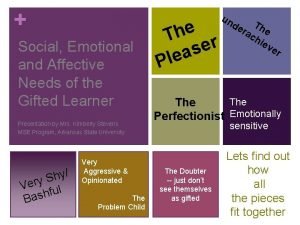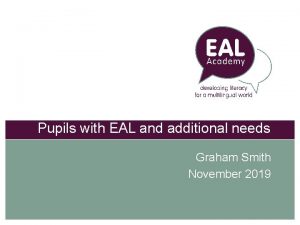TEACHING EAL STUDENTS The changing needs of students











- Slides: 11

TEACHING EAL STUDENTS

The changing needs of students 2013 = Just over 1 million 1997 = 500, 000 § There are currently over 1. 5 million learners with English as an Additional Language (EAL) in UK maintained schools and many more in independent schools. § EAL learners represent just over 21% of the primary population and nearly 17% of the secondary population in England.

■ Current policy is to integrate new children into the classroom as quickly as possible, even if they have little English. ■ Knowing little English does not mean a lack of potential to learn. Students should be placed in middle or top sets, as being immersed in the language is the quickest way to learn it.

Tips for teaching EAL students 1. Find out what languages they speak and read. How much English do they know? 2. Seat them at the front of the class. This makes it easier to check on them (non verbal) and for them to see the pictures and text. 3. Don’t try and translate sentences with Google translate.

4. Give EAL students a visual glossary of key vocabulary to stick in their book. This might also include sentence structure.

5. Allow EAL students to sit next to a friendly and reliable student. 6. Summarise instructions to the class/individual. Keep “teacher talk” to a minimum. 7. Slow your speed of delivery. 8. Avoid sayings: “Alright? ” meaning: “Hey, how are you? ” “I'm knackered!” meaning: “I'm tired. ” “I'm chuffed to bits!” meaning “I'm very pleased. ”

9. Wherever possible demonstrate what you need them to do. Or support your words with actions. 10. Don’t over correct their mistakes! Praise their attempt, effort or hard work. 11. Differentiate! This may mean a completely different task – i. e. matching keywords and pictures or completing sentences. Single word answers should be expected for students with very little English. As their experience grows encourage fuller sentences. 12. It’s normal for EAL students to be silent to begin with. A smile and a thumbs up can go a long way to improving their

How do I differentiate my work for EAL students? The following example is for Evaluating a Model that has been made by the students in the pervious lesson.

Grade A-B Testing and evaluating my model – cut out the table and stick in and answer the questions in detail. Justification Testing Questions (B) Client Testing Self Testing The colours are suitable for the design style. Agree Unsure Disagre e Agre e Unsur e Disagree The packaging is an interesting shape. Agree Unsure Disagre e Agre e Unsur e Disagree The text is easy to read and classy. Agree Unsure Disagre e Agre e Unsur e Disagree It is the correct size to hold 2 chocolates. Agree Unsure Disagre e Agre e Unsur e Disagree Grade A-B Testing and evaluating questions Answer these in full sentences in your book. Explain and justify your answers • • • What where the needs of your client and does your design meet them? Did you have any problems while modelling and how did you fix them? Do you think your model is successful and why? How are you going to improve the design before making your final one? How have you used what you learnt in your research to make your design more suitable? Extension Discuss your product with a peer and include their opinion in your evaluation.

Grade C – D Testing and evaluating my model Identify good and bad features of the model. Grade D …………………………………………………………………………………………………………………………………………………. Testing Questions (D) Client Testing The colours reflect De Stijl Agree Unsure Disagree The packaging is an interesting shape. Agree Unsure Disagree The text is easy to read and classy. Agree Unsure Disagree It is the correct size to hold 2 chocolates. Agree Unsure Disagree Help Box The parts that I like on my model are……. The parts that I dislike on my model are…. Self Testing Summary of my testing. Grade C What have you learnt from the testing table and how will you make your design better when you make your final product? …………………………………………………………………………………………………………………………………………………………………………………………… …………………………………………………………………………………………………………………………………………………………………………………………… ……………………………………………………………………………………… Help Box The table shows me that my model did well on…. . The table shows me that my model did poorly on…. . I would like to improve my model by

Testing my gift box Testing Questions Friend Me Font Colours Shape Size I have made my gift box by using a …………………. I have made it for my friend. ? They want the gift box to be: ? Small? The good things about the gift box are…………. The bad things about the gift box are …………… Big?
 School approaches to the education of eal students
School approaches to the education of eal students Alpha press murray
Alpha press murray Strategic gender needs and practical gender needs
Strategic gender needs and practical gender needs Primary needs and secondary needs
Primary needs and secondary needs Target needs and learning needs
Target needs and learning needs Satisfaction
Satisfaction Project based learning for special education
Project based learning for special education Affective needs of gifted students
Affective needs of gifted students Instructional adaptations for special needs students
Instructional adaptations for special needs students Social emotional needs of ell students
Social emotional needs of ell students Eal continuum victoria
Eal continuum victoria Eal awards
Eal awards





















